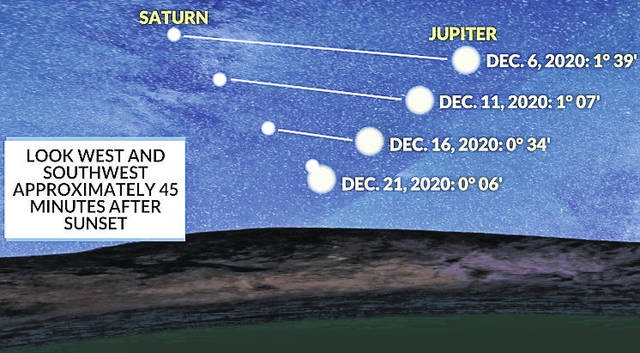
Amateur astronomers in Highland County can witness an event of truly Biblical proportions on the evening of the winter solstice on Dec. 21 when a rare phenomenon will appear in the southwestern sky after sunset.
The event has been nicknamed “The Christmas Star,” in deference to the biblical account found in Matthew’s gospel of the wise men who followed a star that appeared in the eastern sky to guide them to where the Christ child would be found.
The “great conjunction” of the planets Jupiter and Saturn will give the appearance of a “double planet” or a very bright single star, according to NASA, and it’s the first time since just before dawn on the morning of March 4, 1226 that these planets have been seen to be aligned so closely.
NASA said the last time the two planets danced so close in the night sky was in 1623, but both were too near the sun to be seen by earthlings of the Middle Ages.
The space agency said great conjunctions actually occur every 20 years, and that on the evening of Dec. 21, the gas giant and the ringed planet will appear just a tenth of a degree apart, which is about the same as the thickness of a dime held at arm’s length.
Jupiter and Saturn will appear to be very close to each other in the night sky, even though they are actually hundreds of millions of miles apart.
Jupiter orbits the sun at a distance of 484 million miles, while Saturn is nearly twice as far away, circling the sun every 29 years from an average distance of 886 million miles.
Theories abound as to what the Christmas star was.
While Christians believe the star to be a historical fact and a miraculous sign from God, astronomers have long attempted to link its appearance to unusual celestial events such as planetary conjunctions, a comet or a supernova, while some modern scholars have dismissed it as nothing more than pious fiction created by Matthew himself or later Bible scribes.
Bible professor Dr. Amos Wells, in his 1930 book “Peloubet’s Select Notes on the International Sunday School Lessons,” wrote that in December 1604, the great astronomer Johannes Kepler saw Jupiter and Saturn in conjunction, and that the following May, they were joined by Mars.
Wells said that calculations of planetary orbits revealed that another such conjunction occurred just before the birth of Jesus, and since at the time of his observations a very bright star burst forth in the constellation of Serpens, Kepler conjectured that the Star of Bethlehem was what we would now call a supernova that erupted during the Jupiter/Saturn conjunction.
Another theory is that it was a comet that suddenly appeared in the night sky, as depicted in Giotto di Bondone’s painting “Adoration of the Magi” in 1305.
The European Space Agency (ESA) said that Giotto witnessed the 1301 arrival of Halley’s Comet, and may have used it as an inspiration for his artwork.
ESA later named its 1985 unmanned mission to the comet after Giotto.
Others refer to the Star of Bethlehem as what Webster’s dictionary called a “noble lie” or “pious fiction,” meaning that it was nothing more than a fictional religious narrative.
The 1968 “Encyclopedia of the Bible” defined the term as something that Bible naysayers described as a falsehood written with the intent to encourage, comfort or benefit others, but still being nonetheless a lie.
Wells concluded that whatever the Star of Bethlehem was, it acted in accordance with the laws of nature, and didn’t detract from the miracle of Jesus’ birth, but rather added to it.
NASA said the next time a super-close Jupiter/Saturn conjunction will occur will be in 60 years when they usher in spring, on March 15, 2080.
Reach Tim Colliver at 937-402-2571.


